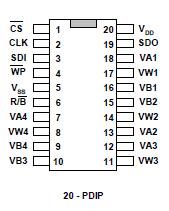WMS7204: Features: • 256 taps for each potentiometer• Four independent, linear-taper channels in one package• End-to-end resistance available in 10K, 50K and 100K• Selectable output b...
floor Price/Ceiling Price
- Part Number:
- WMS7204
- Supply Ability:
- 5000
Price Break
- Qty
- 1~5000
- Unit Price
- Negotiable
- Processing time
- 15 Days
SeekIC Buyer Protection PLUS - newly updated for 2013!
- Escrow Protection.
- Guaranteed refunds.
- Secure payments.
- Learn more >>
Month Sales
268 Transactions
Payment Methods
All payment methods are secure and covered by SeekIC Buyer Protection PLUS.

 WMS7204 Data Sheet
WMS7204 Data Sheet








